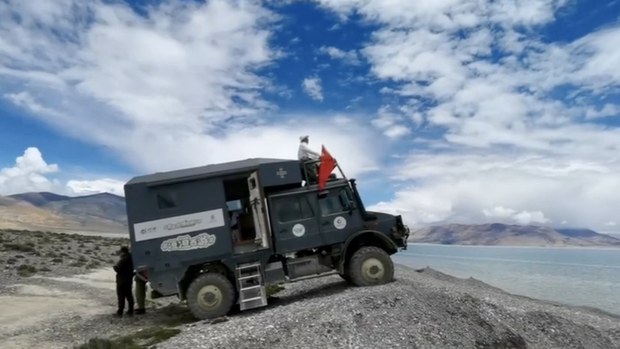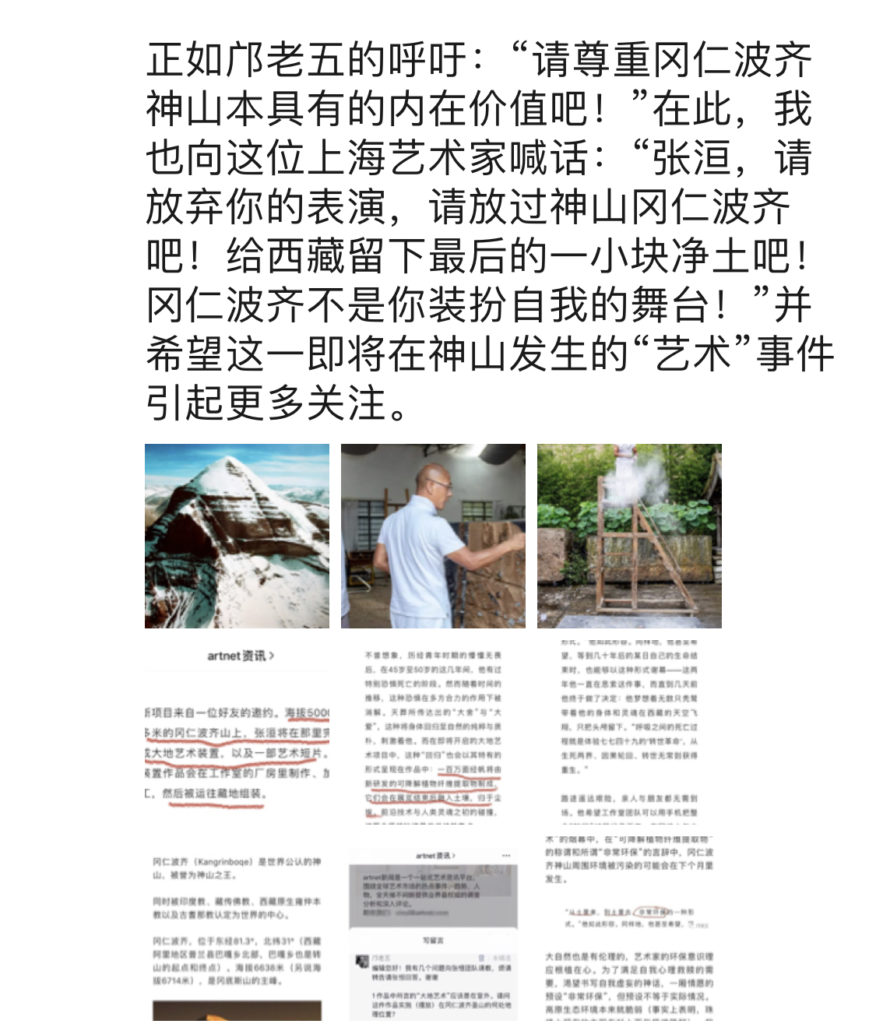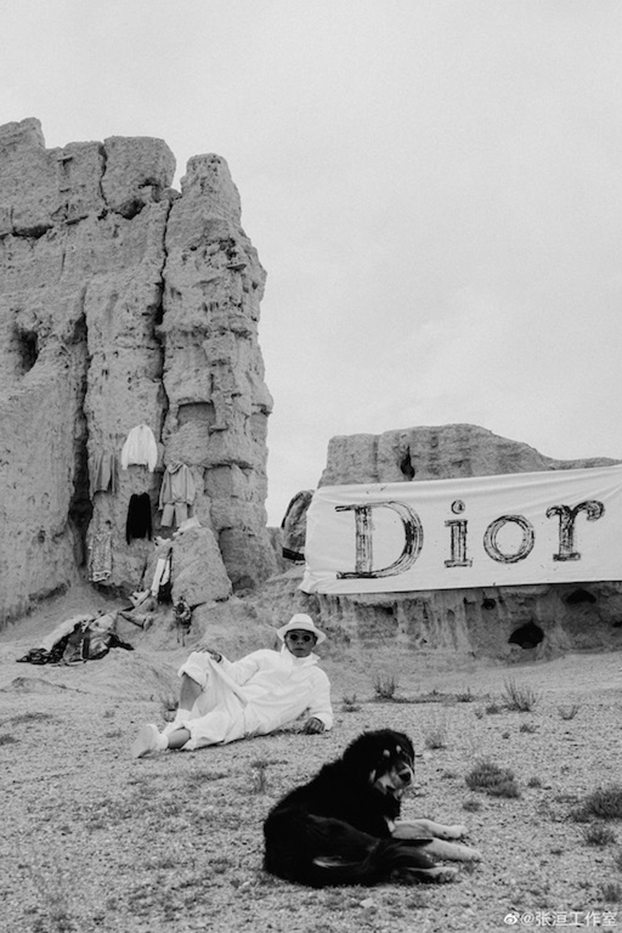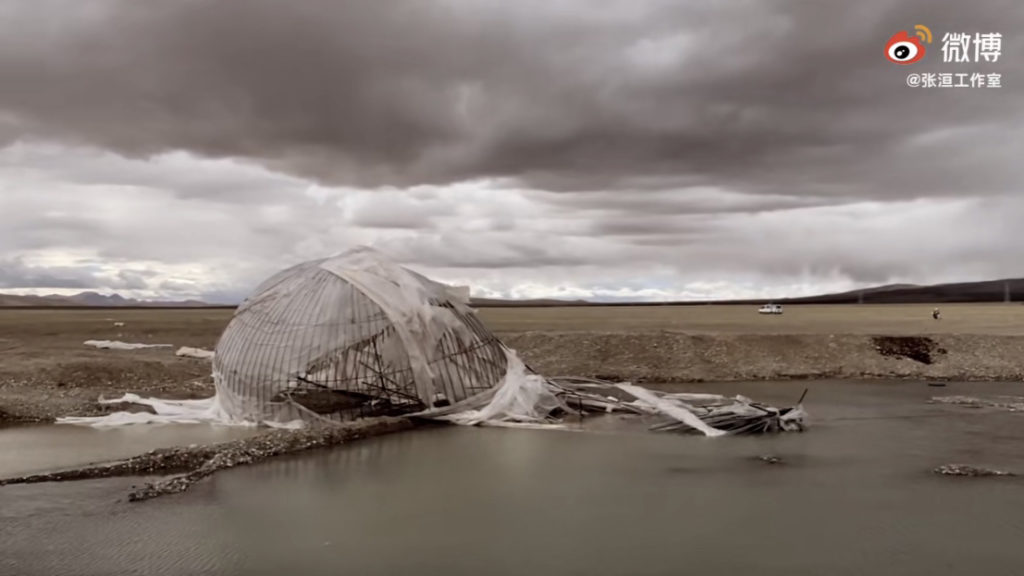High Peaks Pure Earth presents an English translation of the second part of two blogposts by Woeser, originally written for the Mandarin service of Radio Free Asia and published on her blog on October 20, 2020.
The post was prompted by Chinese contemporary artist Zhang Huan’s art installations that took place in Tibet near Mount Kailash a few months ago. The art installations were met with opposition by Woeser and Tibetan artist Kuang Laowu who voiced his concerns on WeChat and Weibo. In the past, Woeser has written about the restrictions on Tibetans who wish to go to Mount Kailash on pilgrimage. She has also written about the effects of commercialisation and tourism on places like Mount Kailash and Lake Manasarovar.
Please read the first part of the essay here.
“Our Sacred Land, Their Rubbish Dump (Part 2): Chinese Artist Zhang Huan’s ‘Land Art’ Installation on Mount Kailash” By Woeser

- Zhang Huan’s “Land Art” installation on Mount Kailash was a subject of heated discussion on Twitter, Facebook, Weibo and other social media platforms for several days. To prevent these debates from disappearing into the vast online world, I thought it necessary to select some and summarise them here:
The Hong Kong writer Pazu Kong who previously spent 12 years in Tibet commented: Tibet’s most sacred place, the holy Mount Kailash, was appropriated by an artist coming from Han areas for the promotion of art and salvation. Tibetans are not able to obtain a border permit in their lives to even visit Mount Kailash once; Chinese people, in contrast, can just recklessly turn this place into their own playground, this is absurd beyond words.
My comment: Tibetans are restricted from entering Lhasa; Tibetans are even more severely restricted from going on a pilgrimage to the holy Mount Kailash and other sacred places–mainly because they are not given a “border permit”–but at the same time, this so-called artist who claims to have been Tibetan in a former life and the only Han Chinese Sky Burial Master in his current life, he is not only able to freely come and go, he is even allowed to set up a “high tech environmental protection project” on the holy mountain to satisfy his lust for performance and to win the support from the industry. This reality is really just too cruel.
Ai Weiwei commented: Zhang Huan who is responsible for the sculpture of the two cuddly Giant Pandas “He He and Xie Xie” that appeared at the Shanghai World Expo should not touch Tibet. This clearly has a powerful political intention and is completely disrespectful to Tibetans; it is blasphemy.

The writer Tang Danhong commented: This is a big advertisement campaign of companies and other sponsors related to the “advanced technology of biodegradable plant fiber composites,” it is a savage and shameless commercial project packaged as “land art,” facilitated by capital and power. Colonialists misappropriated and manipulated elements of the local culture of the colonised, conducting a disgusting act of blasphemy, it is the essence of collective evil.
My comment: Zhang Huan’s so-called biodegradable material is just nonsense. The only question is really whether or not it can be recycled. At the peak of Mount Chomolungma not even feces can degrade. A report stated: “There are dead bodies to the left and feces to the right. The world’s highest mountain peak is currently drowning in rubbish…”
Woeser’s comment: From Zhang Huan’s Weibo it becomes clear that his “land art” installation in Tibet is sponsored by international brands like LV and Dior. I wonder if these brands actually know about the environmental implications of Zhang Huan’s project, about the damage and pollution that he inflicts upon this sacred land?

Tang Danhong commented: International brands rely on “art” to concoct a vibrant image for themselves with the aim to generate more sales from vulgar consumers. Dior, LV etc. and people like Zhang Huan need each other. If Zhang Huan did not exist, well, there would be someone else, Li Huan or Wang Huan who would plot with these brands, damaging and polluting the natural and spiritual environment in the name of “art.” But in normal countries, it would not be so easy for them to just do whatever they want to; only with the support of an authoritarian regime can they produce such shameless and selfish rubbish.
Pazu Kong commented: In the eyes of foreigners, France not only stands for famous brands and fashion, it also stands for other values, such us “liberte, egalite, fraternite,” which has influenced many people in many corners of the world. French brands’ aura is not only found in its design, but in other values that they bear. But as they enter China today, they not only abandon their universal principles, they even become destructive; this is really so extremely disappointing.

My comment: These international brands fawn over power and help people like Zhang Huan who come with the virus of cultural imperialism to pollute the pure land of the plateau; this should be condemned and stopped.
Pazu Kong commented: To trample on this sacred place in the name of art is outrageous. How can such an “art installation” be allowed in such a strictly controlled area? Where are the limits? Who can set limits?
A Tibetan netizen commented: They have now also cast their eyes on Mount Kailash!

A Tibetan netizen commented: This artist once used fresh yak blood to paint the stairway to heaven at a Lhasa exhibition; he was also scolded and resisted against back then; he wants to be extreme and crazy, he wants to create something big and shocking, but he’s still unable to escape the fact that he knows nothing about Tibetan culture and spiritual life. If one wants to really understand Tibetan culture, the very first lesson is to understand how to be humble and to let go of arrogance.
- Mount Kailash is the sacred place of four ancient religions, so it is not surprising that we see devotees from Tibet and India coming to this holy mountain. But today, among those who are allowed to circumambulate the mountain we rarely see Tibetan Buddhists or Hindiusts. In fact, we can say that people from these religions are completely absent. So who are the people who come here? They are cultural imperialists like Zhang Huan. They have occupied every corner of this sacred place. They wreak havoc, they boss around, they deliberately modify history and retell the story of this place in whatever way they wish. To give you one example: they boast about telling the story of the “Childhood of Mount Kailash,” but even manage to misspell the Tibetan name of the mountain; can it be more ridiculous?!
The absence of local people and believers and the simultaneous occupation of outsiders and non-believers is simply shocking. The scenes of sheep and the horse playing a supporting role in the “Noah’s Ark” video and are being pushed around by Zhang Huan, serve as a thought-provoking metaphor. But of course, he is protected by the official red stamp, so sheep and the horse are nothing; if he wanted to, he could get a group of “liberated serfs” dressed in festive garments, holding up pure white khatas to surround him and his “Noah’s Ark” performance.
From Zhang Huan’s Weibo and from various Chinese media reports we know that after completing his “creative journey to the west,” he held a big “celebration banquet” in Lhasa where he screened the video and displayed “his creative journey that was so full of humanistic spirit.” Some important local artists from Lhasa were also invited to this “celebration banquet,” of which at least half were Tibetans. I took a close look at the photos and would really like to know what these Tibetan artists and writers thought of this “Noah’s Ark” sinking in the lake or of the fashion brands put up on the ruins of a monastery. Were they indifferent? Or were they secretly moved and wished to be part of it? Or did they feel uncomfortable, thinking that this was inappropriate? It was really impossible to see anything from their poker faces; it was like they had become toughened up against any kind of humiliation. It’s impossible that they did not understand the damage that this “Noah’s Ark” inflicted upon the natural environment. It’s impossible that they wouldn’t think of the fashion show on the ruins of a monastery as being totally over the top. Or do they actually think that as long as it is in the name of art, anything goes, any blasphemy and trampling is ok? I would like to know which of these Tibetan artists and writers have actually been on a pilgrimage to Mount Kailash? Well, even if they have, I am sure it was not easy for them to get that “border permit” and they could never have moved around so freely and openly as Zhang Huan.
Even though Tibetan artist Kuang Laowu’s Weibo post instigated a heated debate, there were almost no fellow Tibetan artists who left comments, which worried Kuang Laowu: “Lhasa artists, your silence makes me very sad.” I also felt sad. Not so long ago, artists from Lhasa used “exploring sounds” to act as the most basic principle in the hope of using art to record and reveal the multiple changes and crises faced by contemporary Tibet. They wished to use art to give a voice to the deep pain felt by Tibetans today; but now they have become silent like stagnant water. Artistic expressions used to be sharp, profound or sad; now they are stagnant, remaining at the level of depicting traditional Tibetan symbols, but these are either completely empty or completely meaningless. Of course, under increasingly heavy pressure today, you cannot help but become cynical, complicit and silent; this is understandable. But that they did not even raise their voices just a tiny bit is really disappointing.

- Actually, Mount Kailash, this place of incomparable sacred value, has not only been damaged by Zhang Huan’s “Land Art.” Over the past years, there have been many other forces, like mining, tourism, hunting etc. simply too many bigger and smaller disasters to count. For example: the Beijing-based Guofeng Group’s subsidiary, the Tibetan Tourism Company, has been “contracted” to take over the holy Mount Kailash, as well as Lake Manasarovar, and turn them into tourist areas, using the sacred mountain and lake as a convenient advertisement for their initial public offering. The 2010 “Tibetan Kailash Manasarovar Tourism Development Project” includes “the development of the scenic area, the building of hotels and restaurants, the purchasing of environmentally-friendly vehicles, oxygen plants and other facilities, etc” as well as “a big entrance gate, scenic viewing towers, scenic motorcars and roads etc.” Apart from the commercialisation of the sacred, religious site, the construction of oxygen plants and other facilities will also result in greater emissions and pollution to the environment.
The traditional way of circumambulating the mountain has always been on foot; it is completely unnecessary to build roads or have tourist cars travel these paths. On the contrary, roads and touristic cars will only attract even more tourists and hunters. If we take the logic of cultural anthropology, this is a kind of “touristic imperialism” in order to blaspheme and destroy the holy mountain and lake. Local residents can only silently bear witness to this blasphemy, they are powerless.
All that happens in contemporary Tibet has been described and analysed by Wang Lixiong in his book about the past and present of Tibet and the “Tibet question,” titled “Sky Burial: The Fate of Tibet;” in the conclusion he writes: “Tibet is like a human body who has lost all capabilities of movement, lying on the snow-covered rooftop of the world. From all directions, vultures and eagles swoop down on it, tearing its body to pieces to fulfil their own needs–be it for sovereignty, to win over public opinion, demonstrate a certain ideology or for international diplomacy. There are also the greedy and insatiable businessmen, the gunmen and poachers of wild animals, pleasure-seeking tourists and Westerners tired of modern civilisation… all these people pour into Tibet to take what they need from it. Throughout history, Tibet has never been so manipulated by external forces to such a degree as it is now. It has never been so helpless, so confined, and unable to act independently for itself.”
Coincidentally, Zhang Huan, this Chinese artist who talks about “self-salvation in the post-pandemic era” and leaves piles of rubbish in the holy place of genuine believers, labels himself as a “sky burial master.” If we think about it, this is actually quite an appropriate label: Tibet lies on top of the roof of the world; the “sky burial master” Zhang Huan holds the knives of the lingering death (the death of a thousand cuts); with the knife of power he engraves the pattern of the five-starred red flag and with the knife of capital he engraves the label of Dior. Together they greedily rush in to bite and swallow up Tibet, like the vultures that eat up the deceased. These ravaging vultures include international brands as well as Zhang Huan and his team and partners–in his “journey to the west” video, he presents himself as a vulture, so this really makes him a “sky burial master.”
There is a Tibetan proverb: Where there are Gods and Buddhas, demons will also gather. Although the holy Mount Kailash, symbolising the residence of the gods of the four major religions, towers there silently, it does not mean that it is silent and patient. The more exaggerated Zhang Huan’s so-called “self-salvation” performance in the “post-epidemic era” becomes, the more evil it is; this gives special significance to the timeliness of this “artistic act” to kill Tibet.

- What needs to be stressed is that the religious significance of Mount Kailash is not limited to the Tibetan Bon Religion and Tibetan Buddhism, but also includes Hinduism and Jainism; in this sense, it has a very long history and is of immense importance. And because of this, nine years ago, the famous Tibetologist Elliot Sperling put forward some very sharp criticism of the Beijing company trying to develop the mountain and lake areas for tourism: “it is a depressing example of the commodification of what would otherwise be considered a sacred historical site (…) But the degradation of this religious site for the benefit of Chinese investors is not simply another insult for Tibetans to bear; it is a slap too at Indian pilgrims who also venerate Kailash as the abode of Śiva and visit and circumambulate it.”
Other scholars also pointed out that “Mount Kailash and Lake Manasarovar are shared symbols of cultural and spiritual heritage for both Tibet and India. Any desecration of these two holiest of holy places would be an affront to both India and Tibet. It would be akin to the building of a hotel or tourist facility on top of the holy mountains of Jerusalem. If that is not acceptable to Jews, Christians and Muslims, then neither should this not be acceptable to Buddhists and Hindus, whether or not they are religious by nature.”
This is also why on Twitter, I specifically called attention to the fact that in view of the currently highly sensitive Sino-Indian relations, interventions such as Zhang Huan’s really must not get any more excessive. In fact, from Twitter, we could already see that some Indian public intellectuals started paying attention to this disturbing case. At the same time, the internationally renowned anthropologist and Mongolian specialist, Yang Haiying of Shizuoka University, also voiced strong criticism.
As I am still writing this article, the following happened: On October 12, four days after the event had become public, the Ngari Prefecture Environment Bureau issued a response to Kuang Laowu’s inquiry, which I quote here:
“…according to our investigations, the relevant department of Purang county did not receive any application from Zhang Huan and his team regarding the ‘land art’ installation on Mount Kailash; the Barga township government was merely contacted by a member of Zhang Huan’s studio, verbally expressing the idea of doing a “land art” installation on Mount Kailash, which was refused by the Barga township government. On October 10, the Purang county received the inspection report from the local environment bureau and in the afternoon of the same day, the Purang county government contacted Zhang Huan’s studio, which stated that the ‘one million prayer flags’ land art was merely an idea and that they had discarded it and would not go ahead…”
From this it seems that our opposition was effective. The official response is acceptable and worth applauding. Just as Kuang Laowu wrote in his reply: “The only manner in which such issues can be dealt with is through openness and transparency.” Indeed, this had to be made known to the world, or else Zhang Huan would probably take his “one million prayer flags,” the five-starred red flag and the Dior banner and put up another show on Mount Kailash.
But Zhang Huan’s explanation that the “‘one million prayer flags’ is merely an idea” is by no means true. If it was just “an idea,” why did “artnet” report on the case, it was there in black and white for everyone to read; and why did they, as the project met public resistance, suddenly delete the post? According to Zhang Huan’s original plans, this enormous “land art project” was going to be put into practice “next month,” so how could it just have been “an idea?” Moreover, shouldn’t Zhang Huan provide some kind of explanation for abandoning the devastated spheroid in the middle of the lake from last August, inflicting severe damage upon the natural environment? To phrase it more directly, we believe that asking Zhang Huan and his international brands to issue an official apology is more than reasonable.
And so we should continue asking the local environment bureau: In view of the fact that the environment has already been polluted, in accordance with the relevant government regulations on environmental protection, should Zhang Huan and the big international businesses supporting him not be dealt with accordingly and held accountable? Otherwise, even if Zhang Huan does not go to Mount Kailash next month, we cannot guarantee that he does not go again later on; and even if he does not go, we cannot make sure that another Zhang Huan will do so in the future.
Written between October 11-15, 2020.




Follow Us!